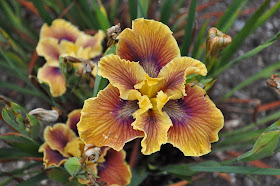BY DAWN MUMFORD
For this post I have some collages and a slide show as a continuation of my last article on how to use photos to extend the iris season. To view my last post click Another Look at Plicata Irises. The theme this time is "Broken Color Irises." Pictured are 4 collages of irises that are in the slide show at the end.

Mike Unser published a great article called Broken Color Iris Terminology in 2012. He introduced the article by saying "in color breaking, a genetic instability causes the colors and/or patterns of the iris to express irregularly giving a flower that is splish-splashed [pattern]in a more or less haphazard fashion. No two blooms are every just alike, and they can create a very lively and exuberant effect in the flower garden."
Mike's article included many pictures of older broken color irises, including 'Victorine' from the 1840's, 'Loreley' from 1929, and many others up to Allen Ensminger's 'Batik' in 1985.
Susanne Spicker also wrote an excellent article here called Broken color irises with Brad Kasperek in 2013. She visited Brad's Zebra Gardens and took many of the pictures that will be in the slide show today.
The slide show in this post is similar to my post last time (here is the link to the last post: Another Look at Plicata Irises). To view the new 3 minute slide show on broken colored irises, click on the button below. Most irises in the show are tall bearded, but not all. Most I grow in my garden, but a few are on my wish list, since many of my broken color irises are new and I don't have pictures of them yet. Susanne is a close friend, and has been gracious in sharing her photos so that you can see them.
You do not have to have Smilebox downloaded on your computer to watch the slide show. Music accompanies the pictures, so adjust your speakers:
Broken Color Slide Show http://www.smilebox.com/playBlog/4e4459304d7a63344f44513d0d0a&blogview=true
While the slide show is loading click on the bottom left button to make the show full screen. It looks like this except yours won't be yellow.
Thanks to Brad Kasperek, Allen Ensiminger and Virginia Messick for your fine skills in hybridizing these beautiful broken color iris. Thanks as well to Susanne Spicker for sharing her pictures.






















































